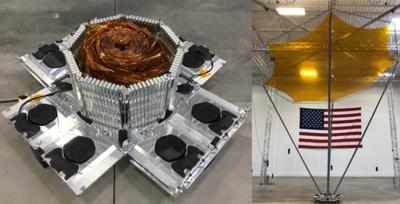Mon, Feb 04, 2019
RF Risk Reduction Deployment Demonstration Targeted For Launch In Late February
DARPA’s Radio Frequency Risk Reduction Deployment Demonstration (R3D2) is set for launch in late February to space-qualify a new type of membrane reflectarray antenna. The antenna, made of a tissue-thin Kapton membrane, packs tightly for stowage during launch and then will deploy to its full size of 7.5 feet in diameter once it reaches low Earth orbit.

R3D2 will monitor antenna deployment dynamics, survivability and radio frequency (RF) characteristics of a membrane antenna in low-Earth orbit. The antenna could enable multiple missions that currently require large satellites, to include high data rate communications to disadvantaged users on the ground. A successful demonstration also will help prove out a smaller, faster-to-launch and lower cost capability, allowing the Department of Defense, as well as other users, to make the most of the new commercial market for small, inexpensive launch vehicles. Satellite design, development, and launch took approximately 18 months.
“The Department of Defense has prioritized rapid acquisition of small satellite and launch capabilities. By relying on commercial acquisition practices, DARPA streamlined the R3D2 mission from conception through launch services acquisition,” said Fred Kennedy, director of DARPA’s Tactical Technology Office. “This mission could help validate emerging concepts for a resilient sensor and data transport layer in low Earth orbit – a capability that does not exist today, but one which could revolutionize global communications by laying the groundwork for a space-based internet.”
The launch will take place on a Rocket Lab USA Electron rocket from the company’s launch complex on the Mahia Peninsula of New Zealand. Northrop Grumman is the prime contractor and integrated the satellite; MMA Design designed and built the antenna. Trident Systems designed and built R3D2’s software-defined radio, while Blue Canyon Technologies provided the spacecraft bus.
(Image provided wit DARPA news release: MMA Design successfully completes deployment testing of its innovative high-compaction ratio reflectarray antenna in its Louisville, Colorado facilities)
More News
Aviation Governance Secured...At Least For a While The National Business Aviation Association similarly applauded the passage of the FAA's recent reauthorization, contentedly recou>[...]
Emphasis On Growing The Future of Aviation Through Concentration on 'AFFORDABLE FLYERS' It's been a number of years since the Latest Edition of Jim Campbell's HUGE SportPlane Resou>[...]
Amazilia Aerospace GmbH, Develops Digital Flight Control, Flight Guidance And Vehicle Management Systems Textron eAviation has acquired substantially all the assets of Amazilia Aer>[...]
Honeywell's Primus Brings New Tools and Niceties for Hawker Operators Hawker 4000 business jet operators have a new installation on the table, now that the FAA has granted an STC f>[...]
Company Celebrates Niche-but-Important Advancement in Industry Standards Echodyne has announced full integration of its proprietary 'EchoFlight' radar into the e American Aerospace>[...]
 Bolen Gives Congress a Rare Thumbs-Up
Bolen Gives Congress a Rare Thumbs-Up The SportPlane Resource Guide RETURNS!!!!
The SportPlane Resource Guide RETURNS!!!! Buying Sprees Continue: Textron eAviation Takes On Amazilia Aerospace
Buying Sprees Continue: Textron eAviation Takes On Amazilia Aerospace Hawker 4000 Bizjets Gain Nav System, Data Link STC
Hawker 4000 Bizjets Gain Nav System, Data Link STC Echodyne Gets BVLOS Waiver for AiRanger Aircraft
Echodyne Gets BVLOS Waiver for AiRanger Aircraft



